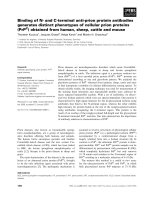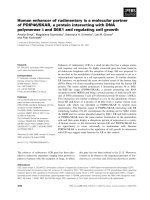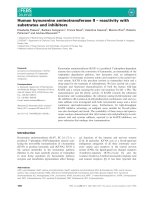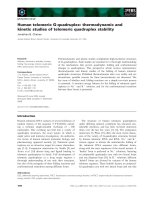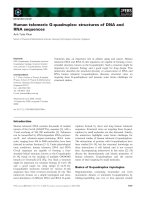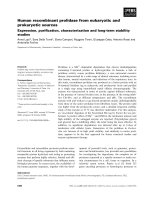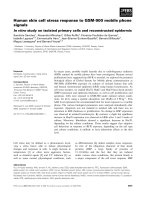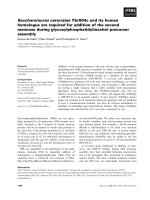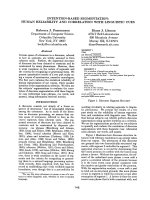báo cáo khoa học: " Human papillomavirus-mediated carcinogenesis and HPV-associated oral and oropharyngeal squamous cell carcinoma. Part 2: Human papillomavirus associated oral and oropharyngeal squamous cell carcinoma" pptx
Bạn đang xem bản rút gọn của tài liệu. Xem và tải ngay bản đầy đủ của tài liệu tại đây (224.23 KB, 6 trang )
REVIEW Open Access
Human papillomavirus-mediated carcinogenesis
and HPV-associated oral and oropharyngeal
squamous cell carcinoma. Part 2: Human
papillomavirus associated oral and oropharyngeal
squamous cell carcinoma
Liviu Feller
*
, Neil H Wood, Razia AG Khammissa, Johan Lemmer
Abstract
Human papillomavirus (HPV) infection of the mouth and oropharynx can be acquired by a variety of sexual and
social forms of transmission. HPV-16 genotype is present in many oral and oropharyngeal squamous cell carcino-
mata. It has an essential aetiologic role in the development of oropharyngeal squamous cell carcinoma in a subset
of subjects who are typically younger, are more engaged with high- risk sexual behaviour, have higher HPV-16
serum antibody titer, use less tobacco and have better survival rates than in subjects with HPV-cytonegative oro-
pharyngeal squamous cell carcinoma. In this subset of subjects the HPV-cytopositive carcinomatous cells have a
distinct molecular profile.
In contrast to HPV-cytopositive oropharyngeal squamous cell carcinoma, the causal association between HPV-16
and other high-risk HPV genotypes and squamous cell carcinoma of the oral mucosa is weak, and the nature of
the association is unclear.
It is likely that routine administration of HPV vaccination against high-risk HPV genotypes before the start of sexual
activity will bring about a reduction in the incidence of HPV-mediated oral and oropharyngeal squamous cell
carcinoma.
This article focuses on aspects of HPV infection of the mouth and the oro pharynx with emphasis on the link
between HPV and squamous cell carcinoma, and on the limitations of the available diagnost ic tests in identifying a
cause-and-effect relationship of HPV wi th squamous cell carcinoma of the mouth and oropharynx.
Introduction
Human papillomaviruses have been categorized by their
genotypes into low-risk and high-risk types according to
the risk of that virus causing squamous cell carcinoma
of the uterine c ervix [1]. Infection of the uterine cervix
with any human papillomavirus (HP V) genotype is asso-
ciated with high-risk sexual behaviour, particularly if
started at a younger age; and persistent infection of the
uterine cervix with high-risk HPV genotypes, especially
HPV-16 and HPV-18, is essential for the development
of squamous cell carcinoma (SCC) [1-3]. Recent
evidence also incriminates high-risk HPV-genotypes in
the pathogenesis of oral and oropharyngeal SCC [4-21],
and it will be the purpose of this paper to explore this
relationship.
HPV infection of the mouth and of the oropharynx,
like HPV infection of the uterine cervix, is associated
with high- risk sexual behav iour, in particular with oro-
genital sex; and high-risk HPV genotypes, in particular
HPV-16, are present in many oral and oropharyngeal
SCC where in some cases they probably play an essen-
tial aetiological role [17]. Persons with oropharyngeal
SCC in which HPV can be detected intracellularly have
a b etter prognosis than pers ons with HPV-cytonegative
oropharyngeal SCC [11,14].
* Correspondence:
Department of Periodontology and Oral Medicine, University of Limpopo,
Medunsa Campus, South Africa
Feller et al. Head & Face Medicine 2010, 6:15
/>HEAD & FACE MEDICINE
© 2010 Feller et al; licensee BioMed Central Ltd. This is an Open Access article distributed under the terms of the Creative Commons
Attribution License ( which permits unrestricted use, distribution, and reproduction in
any medium, provided the original work is properly cited.
The circumstantial evidence for a link between
HPV and squamous cell carcinoma of the mouth
and oropharynx
In order to prove a causal relationship between HPV
and SCC of the mouth and oropharynx, as has been
proven in the case of SCC of the cervix uteri, there
should be evidence that in a significant number of cases
of apparently normal oral or oropha ryngeal epithelium
infected with HPV, in time SCC will develop. The
demonstration of HPV DNA, even of high-risk HPV
oncogenes in squamous cell carcinoma is not in itself
sufficient evidence of oncoge nesis by the HPV in that
context. HPV may well have been either present but a
non-participant during the oncogenesis, or have been
superimposed upon the malignancy.
On the other hand, absen ce of HPV DNA from an y
carcinoma does not exclude the theoretical possibility
of its having played some role in the initiation of the
malignancy since HPV infections are frequently transi-
ent [7]. In such a ‘hit and run’ situation, HPV may
incite initial transformation in cel ls that subsequently
lose their HPV DNA sequences during carcinogenesis
[8]. However, this is highly improbable since per sis-
tence of oncoproteins E6, E7 of the high-risk HPV
genotypes appears to be necessary for the perpetuation
of HPV-associated malign ancy, as is evident from the
presence of HPV DNA in the cells of SSC of the uter-
ine cervix [9].
The local viral load and viral distribution, the clonality
of HPV infection, the mechanisms of HPV oncogene
transcription, and the specific site of viral integration
are all factors critical to the understanding of HPV
oncogenesis; and the testing for these factors is as com-
plex and as multifaceted as the complexity of the pro-
cess itself.
In situ hybridization assays for HPV DNA can provide
data on the presence of HPV in different cells, but have
limited sensitivity for certain HPV genotypes and cannot
demonstrate oncogene transcription. Viral oncogene
expression can be d emonstrated by the polymerase
chain reaction (PCR) technique, but this does not pro-
vide information about the viral load and the distribu-
tion of HPV DNA [9]. As PCR can detect very small
fragments of HPV DNA that may just be tissue contam-
ination or biologically insignificant HPV infection, PCR
findings without quantifying the DNA viral load or iden-
tifying HPV transcriptional activity are not significant in
relation to HPV oncogenesis [22,23]. Neither PCR nor
in situ hybridization tests can pinpoint the specific site
of viral integration in the genome [9]. PCR combined
with in situ hybridization can detect HPV-infected cells
with low viral loads, and can also elucidate the distribu-
tion of HPV DNA within the tumour [10].
Circumstantial evidence for the role of high-risk HPV
types in the pathogenesis of SCC of the mouth and
oropharynx can be found, firstly, in the presence of
high-risk HPV genomic sequences and expression of
transcriptionally active E6/E7 oncoproteins in the malig-
nant cell nuclei of the tumour and of its metastases;
secondly, i n HPV DNA integration in the cellular gen-
ome; and thirdly, in the existence of substantial viral
DNA copy-numbers [9,11,12,24].
In relation to H PV viral load, although there is a
clearly demonstrated association between increased
HPV DNA copy-number (viral load) and increased risk
of cervical cancer, this viral load is not a reliable predic-
tor of HPV-induced progression to cervical cancer; and
presumably , viral load will be no more reliable as a pre-
dictor of HPV-induced progression to oral and orophar-
yngeal cancer. Determination of viral load cannot
discriminate between HPV infection of a few cells with
a large number of HPV DNA copies each, and of many
cells with a few DNA copies each; or between recent
HPV infection and long-standing infection [25].
Regarding HPV DNA integration into the cellular gen-
ome, although this molecular event is a strong indica-
tion of the oncogenic role of the virus, the presence of
high HPV DNA copy-numbers and transcriptionall y
active (high risk) E6/E7 mRNA in HPV cytopositive
SCC of the oropharynx is not necessarily dependant on
viral integration and can occur when the virus is in an
episomal form [26].
Acquisition of oral and oropharyngeal HPV
infection
Both oral and oropharyngeal HPV infection and oral
and oropharyngeal SCC are associated with the practice
of orogenital sex and with the high-risk sexual beha-
viour of cohabiting with many partners, particularly
when started at a younger age [7,12,15,17,19,27]. In a
study primarily aimed at vulvogenital HPV infection,
tobacco smoking and increasing age were found to be
risk factors associated with increased frequency of per-
sistent oral HPV infections in women [28]. This appears
to be because tobacco-mediated and age-related local
genetic and immune dysregulation renders the tissues
more susceptible to HPV infection [28].
Although oral and oropharyngeal HPV infections are
primarily sexually acquired, mouth to mouth contact
between partners and between family members, autoino-
culation, and ve rtical birth-transmission are also rou tes
whereby HPV infection of oral and oropharyngeal sites
can be established [15,27,29].
As oral and oropharyngeal subclinical HPV infec tion
is not uncommon, it is possible that the epithelium may
serve as a reservoir of the virus, and when activated the
Feller et al. Head & Face Medicine 2010, 6:15
/>Page 2 of 6
virus may play a role in HPV-associated oral and oro-
pharyngeal SCC.
The role of HPV in oral and oropharyngeal SCC
In epidemi ological studies, SCC of the head and neck is
frequently treated as a homogeneous group, and the var-
ious component carcinomata (oral, oropharyngeal, laryn-
geal, nasoph aryngeal, hypopharyngeal etc.) are not often
separated out statistically. The reported rates of detec-
tion of HPV DNA in head and neck SCC range from 0
to 100% [15,30]. This extreme variation in reported pre-
valence may be owing to lumping together of essentially
different lesions; to small sample numbers; and to differ-
ences in the sampling techniques; in the ethno-geo-
graphic origins of the subjects examined; and in the
HPV detection methods applied [13,23,31].
Understanding of the role of HPV in the pathogenesis
of oral and o ropharyngeal SCC is further clouded by
inconsistencies in the evide nce brought about by differ-
ences i n methods of tissue collection and preservation;
by the use of molecular assays and HPV DNA probes
with different specificities and sensitivities; by low viral
load in these carcinomata; by lack of adequate controls;
and by the inability to identify and assess the influences
of other confounding factors [10,16,23]. However, it is
generally accepted that HPV DNA is detected in about
26% of biopsy specimens of SCC of the head and neck
[6,15]; and that these neoplasms, in particular SCC of
the tonsil, contain HPV DNA more frequently than any
other SCC of the head and neck [6,11,23,32]. In a meta-
analysis of data from 94 studies of a total of 4580 speci-
mens, Miller and Johnston (2001) determined that the
prevalence of HPV in normal oral mucosa and in oral
SCC is likely to be 10% and 46.5%, respectively [16].
Coinfection with HPV-16 together with one or more
otherHPVtypesisnotuncommon[10,18].HPV-16
DNA was found to be the most prevalent HPV genotype
in HPV-cytopositive oral and oropharyngeal SCC
[6,15,18] and was detected in about 75% of cases of
HPV-cytopositive oral SCC and in about 90% of cases of
HPV-cytopositive oropharyngeal SCC [17-19]. A recent
meta-analysis of data from 17 stud ies determined that
there is a significant causal association between HPV-16
and o ropharyngeal SCC, but only a weak association in
the case of oral SCC [23].
Serum antibodies against L1, E6 and E7 proteins of
HPV-1 6 were detected in well over 60% of persons with
oropharyngeal SCC [17]. Since antibodies to HPV-16
capsid protein L1 are strongly associated with oral and
oropharyngeal SCC, and since these antibodies are evi-
dence of long-ter m exposure to HPV-16, it is possible,
indeed probable, that exposure to HPV-16 precedes the
development of oropharyngeal SCC by several years
[7,15,17]. However, this observation mu st be interpreted
with caution since other HPV infections, for instance
anogenital and o ral warts will increase HPV antibody
titres, and this can confound the observed association
between serum HPV antibody levels and oral and oro-
pharyngeal SCC [7]. A s is the case with the virus itself,
HPV-16 seropositivity is strongly associated with
increased risk of developing HPV-cytopositive orophar-
yngeal SCC, but there is only a weak association for oral
SCC [32,33].
Owing to the non-specificity of clinical sampling
methods fo r HPV and to the confounding effect of
benign HPV infection in the mouth or elsewhere, pre-
dicti on of development of HPV-associated oral and oro-
pharyngeal SCC can not yet be made [12,15,34].
HPV-associated and non HPV-associated (tobacco/
alcohol related, idiopathic) oral and oropharyngeal SCC
are different in cytogenetic profiles, clinical characteris-
tics and courses of the disease [11,12]. While HPV-asso-
ciated cytopositive oral and oropharyngeal SCC is
thought to be initiated and maintained by high-risk
HPV E6/E7 oncoprotein-induced dysregulation of cell
cycle control mechanisms, leading to genomic instability
[12,17], HPV-cytonegative oral and oropharyngeal SCC
often show mutation of p53 tumour-suppresso r gene,
frequent loss of heterozygosity (LoH) at chromosomal
loci 3p, 9p and 17p, n ormal or increased levels of pRb,
and decreased levels of p16
INK4A
[35,36]. HPV-asso-
ciated and non-HPV-associated pathogenic mechanisms
result in distinctly different cellular molecular character-
istics [12,20].
It is not yet clear whether the use of tobacco/alcohol
and HPV are, or are not synergistic in the aetiopatho-
genesis of oral and oropharyngeal SCC [11,12], but in a
recent case-controlled study of HPV and oropharyngea l
SCC, no evidence was found for any such synergy [17].
HPV-16 has been shown to be causally associated pri-
marily with HPV-cytopositive SCC of the palatal tonsils
[14,26,32,37] in subjects who typically are younger, are
more engaged with high-risk sexual behaviour (numer-
ous life-time sexual partners and practising oro-genital
sex), have higher HP V-16 serum antibody tite rs, use less
tobacco and alcohol, and have a better rate of survival
than those subjects with HPV-cytonegative oropharyn-
geal SCC [9,11-14,33,38].
In these persons with HPV-cytopositive oropharyngeal
SCC,thetumourcellshaveadistinct molecular profile
[35]. The cells express transcriptionally active mRNA,
frequently show viral integration, high viral load (> 1
copy per cell), functional overexpression of p16
INK4A
,
unmutated p53 gene, and decreased l evels of pRb; and
LoH at chromosomal loci 3p, 9p and 17p is uncommon
[14,24,26,35-37,39-41].
In contrast to cells of H PV-cytopositive SCC of
the oropharynx as described above, the cells of
Feller et al. Head & Face Medicine 2010, 6:15
/>Page 3 of 6
HPV-cyto posit ive oral SCC are typically character ised by
low viral load, and by infrequent viral integration and by
expression of transcriptionally active E6/E7 mRNA
[40,42]. A low-copy number (< 1 copy per cell) or
absence of transcriptionally active E6/E7 mRNA is indi-
cative of limited biological significance in the oncogenic
process [23,35], and of a nonclonal association between
the epitheli al neoplastic proliferation and the HPV infec-
tion [43].
However, it is possible t hat in some cases of HPV-
cytopositive oral SCC that do not express E6/E7 mRNA,
the virus has participated in the initial stages of transfor-
mation but phased out during later stages [43]; or that
HPV super-infection of initially transformed oral kerati-
nocytes may have promoted, in an additive or synergis-
tic manner, the progression of transformation [26].
One m ust not overlook the fact that not all oral and
oropharyngeal SCC are either HPV or tobacco/alcohol
related. Some are idiopathic but the proportion of
idiopathic to HPV and to tobacco-alcohol induced
neoplasms remains undetermined.
Prophylaxis
In view o f the fact that HPV infection is most frequently
sexually acquired and that HPV infection is implicated in
the aetiology of oropharyngeal SCC, and to a lesser
degree in the aetiology of oral SCC, anything that can be
done to discourage early sexual activity and to encourage
safe sexual practices may redu ce the frequency of SCC in
anogenital, oral and oropharyngeal sites.
In addition to the encouragement of responsible sexual
behaviour, the introduction of HPV vaccination as a pub-
lic healt h measure against anogenital HPV i nfection, will
most probably also have a favoura ble impact on the fre-
quency of HPV-mediated oral and oropharyngeal SCC.
The current quadrivalent vaccine against HPV types 6,
11, 16, and 18 consists of L1 protein of HPV which gen-
erates a high level of HPV genotype-specific ne utralising
antibodies [44,45]. The vaccine induces not only a vigor-
ous humoral immune response but also a B cell immune
memory response that persists for about 5 years [46].
The quadrivalent vaccine is highly effective (98%) in
preventing HPV-16 or HPV-18- related high-grade cer-
vical intraepithelial neoplasia in a population of women
aged 15 to 26 who had not been previously exposed to
either HPV-16 or HPV-18; but, the vaccine is much less
effective in women who have previously been exposed
to these HPV types [47]. It is clear, therefore, that vacci-
nation before the onset of sexual activity, which is cer-
tainly t he primary route of transmission, seems t o give
the best preventive benefits [48,49].
Genital HPV infection in men appears to be as com-
mon as it is in women, is also positively related to a his-
tory of sexual activity, but is generally asymptomatic
and is therefore an important occult reservoir of the
virus, contributing significantly to cervical disease in
women. HPV-16 is associated with both penile carci-
noma and male oral and oropharyngeal SCC. T he con-
clusion must be that young men before starting sexual
activity might also be protected from HPV infection and
subsequent oral and oropharyngeal SCC by timeous
prophylactic HPV vaccination; and moreover, their sex-
ual partners can also benefit from this preventive mea-
sure [48,50].
Conclusion
• Oropharyngeal SCC to a higher degree, and to a
lesser degree oral SCC, are associated with HPV
infection.
• Oral and oropharyngeal HPV infection and HPV-
related oral and oropharyngeal SCC occur more fre-
quently in persons who have had a number of sexual
partners and in those who have practised oral sex.
• Social mouth-to-mouth contact, autoinoculation
and vertical birth-transmission are less frequent, but
still important routes of transmission of HPV
infection.
• The importance of latent HPV infection in the oral
and oropharyngeal mucosa as a reservoir of the
virus, is undetermined.
• Reliable markers for progression of high-risk HPV-
infected epithelium to malignancy are not yet
available.
• It is unknown whether co-infection by more than
one HPV genotype increases the risk of malignancy,
and in the event that it does, whether that malig-
nancy will be more aggressive than that following
infection with a single HPV type.
• A number of factors t hat may well prove to be
important in HPV-induced carcinogenesis still
remain uncertain:
• the role of immunity;
• variations in genetic profiles of host and virus;
• thespecificnatureof,andthesequenceofthe
cytogenetic alterations;
• the influences inherent in specific anatomical
sites on carcinogenesis.
Authors’ contributions
LF and RAGK contributed to the literature review. LF, JL and NHW
contributed to the conception of the article. LF, JL, NHW and RAG
contributed to the manuscript preparation. Each author reviewed the paper
for content and contributed to the manuscript. All authors read and
approved the final manuscript.
Competing interests
The authors declare that they have no competing interests.
Received: 10 November 2009 Accepted: 15 July 2010
Published: 15 July 2010
Feller et al. Head & Face Medicine 2010, 6:15
/>Page 4 of 6
References
1. Steben M, Duarte-Franco E: Human papillomavirus infection:
Epidemiology and pathophysiology. Gynecol Oncol 2007, 107:S2-S5.
2. Walboomers JM, Jacobs MV, Manos MM, Bosch MS, Kummer JA, Shah KV,
Snijders PJ, Peto J, Meijer CJ, Munoz N: Human papillomavirus is a
necessary cause of invasive cervical cancer worldwide. J Pathol 1999,
189:12-19.
3. Monk BJ, Tewari KS: The spectrum and clinical sequelae of human
papillomavirus infection. Gynecol Oncol 2007, 107:S6-S13.
4. Schwartz SM, Daling JR, Doody DR, Wipf GC, Carter JJ, Madeleine MM,
Mao EJ, Fitzgibbons ED, Huang S, Beckmann AM, McDougall JK,
Galloway DA: Oral cancer risk in relation to sexual history and evidence
of human papillomavirus infection. J Natl Cancer Inst 1998, 90:1626-1636.
5. Smith EM, Ritchie JM, Summersgill KF, Hoffman HT, Wang DH, Haugen TH,
Turek LP: Human papillomavirus in oral exfoliated cells and risk of head
and neck cancer. J Natl Cancer Inst 2004, 96:449-455.
6. Kreimer AR, Clifford GM, Boyle P, Franceschi S: Human papillomavirus
types in head and neck squamous cell carcinoma worldwide: a
systematic review. Cancer Epidemiol Biomarkers Prev 2005, 14:467-475.
7. Mork J, Lie AK, Glattre E, Hallmans G, Jellum E, Koskela P, Møller B,
Pukkala E, Schiller JT, Youngman L, Lehtinen M, Dillner J: Human
papillomavirus infection as a risk factor for squamous-cell carcinoma of
the head and neck. N Engl J Med 2001, 344:1125-1131.
8. Syrjanen S: Human papillomavirus infections and oral tumours. Med
Microbiol Immunol 2003, 192:123-128.
9. Gillison ML: Human papillomavirus and prognosis of
oropharyngealsquamous cell carcinoma: Implication for clinical research
in head and neck cancer. J Clin Oncol 2006, 24:5623-5625.
10. Miller CS, Zeuss MS, White DK: Detection of HPV DNA in oral carcinoma
using polymerase chain reaction together with in situ hybridization. Oral
Surg Oral Med Oral Pathol 1994, 77:480-486.
11. Gillison ML, Koch WM, Capone RB, Spafford M, Westra WH, Wu L,
Zaharuk ML, Daniel RW, Viglione M, Symer DE, Shah KV, Sidransky D:
Evidence for a causal association between human papillomavirus and a
subset of head and neck cancers. J Natl Cancer Inst 2000, 92:709-720.
12. Gillison ML, Lowy DR: A causal role for human papillomavirus in head
and neck cancer. Lancet 2004, 363:1488-1489.
13. Syrjanen S: Human papillomavirus (HPV) in head and neck cancer. J Clin
Virol 2005, 32S:S59-S66.
14. Licitra L, Perrone F, Bossi P, Suardi S, M ariani L, Artusi R, Oggionni M,
Rossini C, Cantù G, Squadrelli M, Quattrone P, Locati LD, Bergamini C,
Olmi P, Pierotti MA, Pilotti S: High-risk human papillomavirus affects
prognosis in patients with surgically treated oropharyngeal squamous
cell carcinoma. J Clin Oncol 2006, 24:5630-5636.
15. Syrjanen S: Human papillomaviruses in the head and neck carcinomas.
N Engl J Med 2007, 365:1993-1995.
16. Miller SC, Johnstone BM: Human papillomavirus as a risk factor for oral
squamous cell carcinoma: a meta-analysis, 1982-1997. Oral Surg Oral Med
Oral Pathol Oral Radiol Endod 2001, 91:622-635.
17. D’Souza G, Kreimer AR, Viscidi R, Pawlita M, Fakhry C, Koch WM, Westra WH,
Gillison ML: Case-control study of human papillomavirus and
oropharyngeal cancer. N Engl J Med 2007, 356:1944-1956.
18. Herrero R, Castellsague X, Pawlita M, Lissowska J, Kee F, Balaram P,
Rajkumar T, Sridhar H, Rose B, Pintos J, Fernández L, Idris A, Sánchez MJ,
Nieto A, Talamini R, Tavani A, Bosch FX, Reidel U, Snijders PJ, Meijer CJ,
Viscidi R, Muñoz N, Franceschi S, IARC Multicenter Oral Cancer Study Group:
Human papillomavirus and oral cancer: The international agency for
research on cancer multicenter study. J Natl Cancer Inst 2003,
95:1772-1783.
19. Cameron JE, Hagensee ME: Oral HPV complications in HIV-infected
patients. Current HIV/AIDS Reports 2008, 5:126-131.
20. Haddad RI, Shin DM: Recent advances in head and neck cancer. N Engl J
Med 2008, 359:1143-1154.
21. Ritchie JM, Smith EM, Summersgill KF, Hoffman HT, Wang D, Klussmann JP,
Turek LP, Haugen TH: Human papillomavirus infection as a prognostic
factor in carcinomas of the oral cavity and oropharynx. Int J Cancer 2003,
104:336-344.
22. Hennessey PT, Westra WH, Califano JA: Human papillomavirus and head
and neck squamous cell carcinoma: recent evidence and clinical
implications. J Dent Res 2009, 88:300-306.
23. Hobbs CG, Stern JA, Baily M, Heyderman RS, Birchall MA, Thomas SJ:
Human papillomavirus and head and neck cancer: a systematic review
and meta-analysis. Clin Otolaryngol 2006, 31:461-462.
24. Rampias T, Sasaki C, Weinberger P, Psyrri A: E6 and E7 gene silencing and
transformed phenotype of human papillomavirus 16-positive
oropharyngeal cancer cells. J Natl Cancer Inst 2009, 101:412-423.
25. Wang SS, Hildesheim A: Viral and host factors in human papillomavirus
persistence and progression. J Natl Cancer Inst Monogr 2003, 31:35-40.
26. Weinberger PM, Yu Z, Haffty BG, Kowalski D, Harigopal M, Brandsma J,
Sasaki C, Joe J, Camp RL, Rimm DL, Psyrri A: Molecular classification
identifies a subset of human papillomavirus-associated oropharyngeal
cancers with favourable prognosis. J Clin Oncol 2006, 24:736-747.
27. Kreimer AR, Alberg AJ, Daniel R, Gravitt PE, Viscidi R, Garrett ES, Shah KV,
Gillison ML: Oral human papillomavirus infection in adults is associated
with sexual behaviour and HIV serostatus.
J Infect Dis 2004, 189:686-698.
28. D’Souza G, Fakhry C, Sugar EA, Seaberg EC, Weber K, Minkoff HL: Six-month
natural history of oral versus cervical human papillomavirus infection. Int
J Cancer 2007, 121:143-150.
29. Fakhry C, D’Souza G, Sugar E, Weber K, Goshu E, Minkoff H, Wright R,
Seaberg E, Gillison M: Relationship between prevalent oral and cervical
human papillomavirus infections in human immunodeficiency virus-
positive and negative women. J Clin Microbiol 2006, 44:4470-4485.
30. Ha PK, Califano JA: The role of human papillomavirus in oral
carcinogenesis. Crit Rev Oral Biol Med 2004, 15:188-196.
31. Termine N, Panzarella V, Falaschini S, Russo A, Matranga D, Lo Muzio L,
Campisi G: HPV in oral squamous cell carcinoma vs head and neck
squamous cell carcinoma biopsies: a meta-analysis (1998-2007). Ann
Oncol 2008, 19:1681-1690.
32. Pintos J, Black MJ, Sadeghi N, Ghadirian P, Zeitouni AG, Viscidi RP,
Herrero R, Coutlee F, Franco EL: Human papillomavirus infection and oral
cancer: a case control sudy in Montreal, Canada. Oral Oncol 2008,
44:242-250.
33. Furnis CS, McClean MD, Smith JF, Bryan J, Nelson HH, Peters ES, Posner MR,
Clark JR, Eisen EA, Kelsey KT: Human papillomavirus 16 and head and
neck squamous cell carcinoma. In J Cancer 2007, 120:2386-2392.
34. Campisi G, Panzarella V, Termine N: Letter to the editor - comment on
“human papillomavirus in the oral mucosa of women with genital
human papillomavirus lesions”. Eur J Obstet Gynecol Reprod Biol 2007,
130:142-143.
35. Braakhuis BJ, Snijders PJ, Keune WJ, Meijer CJ, Ruijter-Schippers HJ,
Leemans CR, Brakenhoff RH: Genetic patterns in head and neck cancers
that contain or lack transcriptionally active human papillomavirus. J Natl
Cancer Inst 2004, 96:998-1006.
36. Vidal L, Gillison ML: Human papliiomavirus in HNSCC: recognition of a
distinct disease type. Hematol Oncol Clin North Am 2008, 22:1125-1142.
37. Charfi L, Jouffroy T, de Cremoux P, Le Peltier N, Thioux M, Freneaux P,
Point D, Girod A, Rodriguez J, Sastre-Garau X: Two types of squamous cell
carcinoma of the palatine tonsil characterized by distinct etiology,
molecular features and outcome. Cancer Lett 2008, 260:72-78.
38. Sturgis EM, Cinciripini PM: Trends in head and neck cancer incidence in
relation o smoking prevalence: an emerging epidemic of human
papillomavirus-associated cancers? Cancer 2007, 110:1429-1435.
39. Wiest T, Schwarz E, Enders C, Flechtenmacher C, Bosch FX: Involvement of
intact HPV 16 E6/E7 gene expression in head and neck cancers with
unaltered p53 status and perturbed pRb cell cycle control. Oncogene
2002, 21:1510-1517.
40. Koskinen WJ, Chen RW, Leivo I, Makitie A, Back L, Kontio R, Suuronen R,
Lindqvist C, Auvinen E, Molijn A, Quint WG, Vaheri A, Aaltonen LM:
Prevalence and physical status of human papillomavirus in squamous
cell carcinoma of the head and neck. Int J Cancer 2003, 107:401-406.
41. Klussmann JP, Weissenborn SJ, Wieland U, Dries V, Kolligs J,
Jungehuelsing M, Eckel HE, Dienes HP, Pfister HJ, Fuchs PG: Prevalence,
distribution, and viral load of human papillomavirus 16 DNA in tonsillar
carcinomas. Cancer 2001, 92:2875-2884.
42. Ha PK, Pai SI, Westra WH, Gillison ML, Tong BC, Sidransky D, Califano JA:
Real-time quantitative PCR demonstrates low prevalence of human
papillomavirus type 16 in premalignant and malignant lesions of the
oral cavity. Clin Cancer Res 2002, 8:1203-1209.
43. van Houten VM, Snijders PJ, van den Brekel MW, Kummer JA, Meijer CJ, van
Leeuwen B, Denkers F: Biological evidence that human papillomaviruses
Feller et al. Head & Face Medicine 2010, 6:15
/>Page 5 of 6
are etiologically involved in a subgroup of head and neck squamous
cell carcinomas. Int J Cancer 2001, 93:232-235.
44. Stanley M: Prevention strategies against human papillomavirus: The
effectiveness of vaccination. Gynecol Oncol 2007, 107:S19-S23.
45. Haug CJ: Human papillomavirus vaccination - Reasons for caution. N Engl
JMed2008, 359:861-862.
46. Ault KA: Long-term efficacy of human papillomavirus vaccination.
Gynecol Oncol 2007, 107:S27-S30.
47. The future 11 study group: Quadrivalent vaccine against human
papillomavirus to prevent high grade cervical lesions. N Engl J Med 2007,
356:1915-1927.
48. Giulliano AR: Human papillomavirus vaccination in males. Gynecol Oncol
2007, 107:S19-S26.
49. Sawaya GF, Smith-McCune K: HPV-vaccination - more answers, more
questions. N Engl J Med 2007, 356:1991-1993.
50. Baden LR, Curfman GD, Marrisey S, Drazen JM: Human papillomavirus
vaccine - opportunity and challenges. N Engl J Med 2007, 356:1990-1991.
doi:10.1186/1746-160X-6-15
Cite this article as: Feller et al.: Human papillomavirus-mediated
carcinogenesis and HPV-associated oral and oropharyngeal squamous
cell carcinoma. Part 2: Human papillomavirus associated oral and
oropharyngeal squamous cell carcinoma. Head & Face Medicine 2010
6:15.
Submit your next manuscript to BioMed Central
and take full advantage of:
• Convenient online submission
• Thorough peer review
• No space constraints or color figure charges
• Immediate publication on acceptance
• Inclusion in PubMed, CAS, Scopus and Google Scholar
• Research which is freely available for redistribution
Submit your manuscript at
www.biomedcentral.com/submit
Feller et al. Head & Face Medicine 2010, 6:15
/>Page 6 of 6
